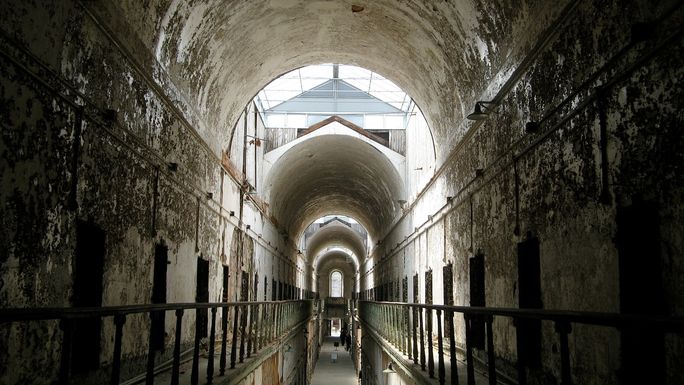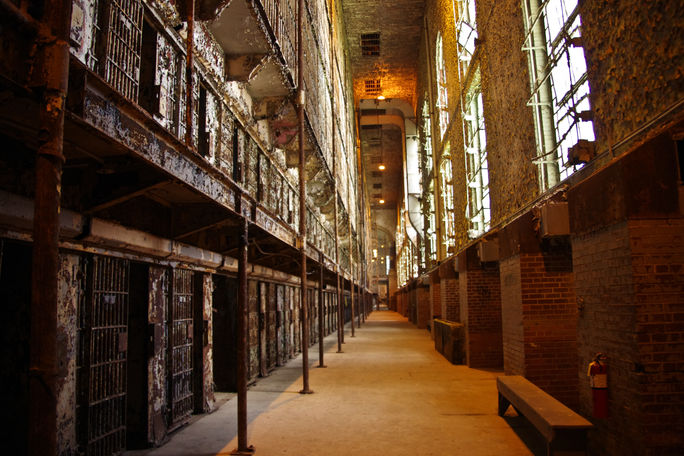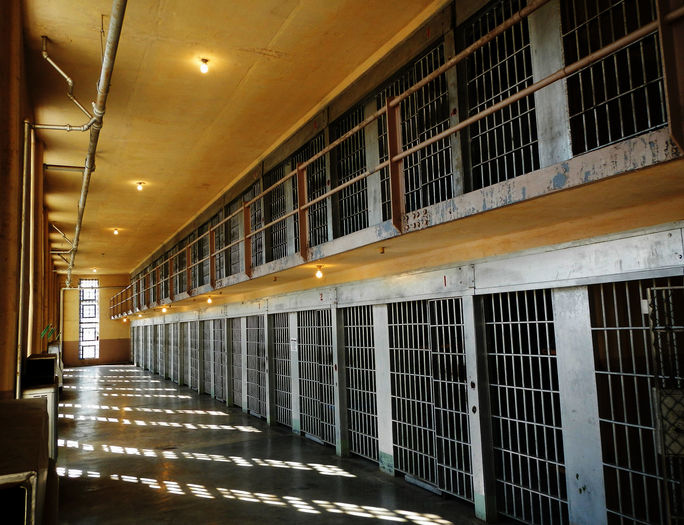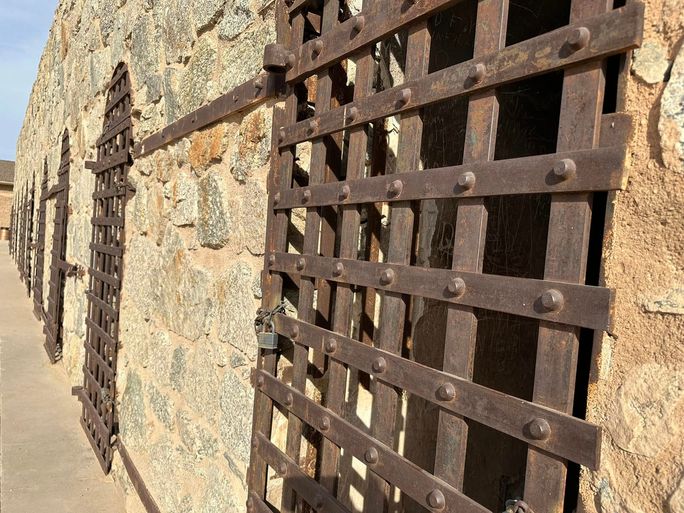Dark Tourism embraces sites associated with death, tragedy
and the macabre. Though it may be a new description, itˇŻs certainly not a new
phenomenon. Travelers into this morbid side of travel have a penchant for
places historically associated with death and tragedy. But even those not
totally into the deep dive of the morbid and grim, are fascinated with places
and events which stir up complicated ethical issues and show us the darker side
of humanity.
Notorious prisons are part of the dark
tourism fascination. And travelers donˇŻt have to just read about their
histories in a book or story, they can actually visit the places that once
housed notorious inmates and provide glimpses into a ghastly past. Here are
those places you can still visit today.??
Alcatraz Island
Likely the most popular abandoned prison in the U.S.,
Alcatraz Island, located in San
Francisco Bay is best-known for its time as a maximum-security federal
penitentiary. It housed some of AmericaˇŻs most notorious criminals including Al
Capone, George ˇ°Machine Gunˇ± Kelly and Robert Stroud, aka the ˇ°Birdman of
Alcatraz.ˇ±?
The prison was considered inescapable due to cold, strong
bay currents and its high security design. Of the 36 men in 14 escape attempts
between 1934 and 1963, only five were never found, though itˇŻs believed they
couldnˇŻt have survived. Alcatraz Island is now part of the Golden Gate National
Recreation Area, managed by the National Park Service. Access is by ferry from
Pier 33 and tours include the prison cell blocks, guard towers, lighthouse and
more by guided tour.??

PHOTO: Eastern State Penitentiary. (photo via Flickr/rob zand)
Eastern State Penitentiary
This historic and famously haunted prison in Philadelphia,
Pennsylvania opened in 1829 and closed in 1971. The prison pioneered the idea
of ˇ°penitence through solitudeˇ± where prisoners were kept completed isolation
in small private cells. Even guards wore felt on their shoes. While
well-intended, the isolation often led to severe mental deterioration. Punishments
such as the iron gag and water dousing were brutal.
Chicago mob boss, Al Capone served eight months here on a
weapons charge. Overcrowding and aging infrastructure eventually led to the prisonˇŻs
closure. But some prisoners never left as shows like Ghost Hunters, Ghost
Adventures and The Travel Channel have all noted reports of shadowy figures,
disembodied voices and footsteps and screams in Cellblock 12.? Day and nighttime tours are available to the
public.
West Virginia State Penitentiary
The notorious prison located in Moundsville, operated from
1876 to 1995. Its imposing Gothic-style architecture and history of harsh
conditions have made it a significant area landmark.
Though the prison was designed to hold up to 250 prisoners,
it often held far more and became infamous due to its violent history and riots
due to overcrowding and unsanitary conditions, mistreatment and abuse.
Executions were carried out until 1959 in an infamous electric chair chamber.
Due to its deterioration and the expense of maintenance, the penitentiary
closed in 1995.
Since its closure, the prison has been preserved as a
historic site, open for public tours, which include walking through cell blocks
and the execution chamber. Ghost tours are available for those interested in
the supernatural aspects of its history.
?

Inside the The Ohio State Reformatory (Photo via Niagara66 / Wikimedia Commons)
The Ohio State Reformatory?
?Located in Mansfield, the reformatory features a mix of
Romanesque, Gothic and Queen Anne design appearing more like a castle than a
prison. OSR is world-famous as the filming location of The Shawshank
Redemption, considered one of the greatest films ever made.
At one time the facility for young, non-violent offenders
was focused on reform through education, religion and hard work but, over time,
conditions worsened, and it became more of a traditional, overcrowded prison.
Over 200 deaths occurred inside, including murders, suicides and a deadly flu
outbreak. Today, the reformatory is considered one of the most haunted places
in the Midwest. Visitors can engage in self-guided and guided tours, ghost
hunts and even overnight paranormal investigations.
Sing Sing
Another famous and historic prison, Sing Sing is located on
the banks of the Hudson River about 30 miles north of New York City. Its name
comes from the Sint Sinck Native American tribe and was built by inmate labor
from Auburn Prison.
The maximum-security prison still houses male inmates and is
famous for its electric chair, ˇ°Old Sparky,ˇ± used for over 600 executions
between 1891 and 1063. These include Julius and Ethel Rosenberg and notorious
serial killers, David Berkowitz and Albert Fish. Though visitors cannot visit
the inside of the prison itself, the Sing Sing Prison Museum offers exhibits
and walking tours around the edges of the correctional facility and offers
stories and information about the prisonˇŻs past and present.

Old Idaho Penitentiary, Cell House 4 (Photo via Eric Friedebach / flickr)
The Old Idaho Penitentiary
Located in Boise, this fascinating piece of American history
is known for its long and often violent past. The prison opened in 1872 and
used the ˇ°Pennsylvania System,ˇ± focusing on solitary confinement to
rehabilitate prisoners but over time became more of a reform school for the
criminally violent.
Notorious criminals included Tommy ˇ°The Knifeˇ± Carroll, a
famous gangster and one of the penitentiaryˇŻs most dangerous inmates and Harry
Orchard, convicted for the 1905 bombing of former Idaho governor, Frank
Steuenberg. The prison had a high level of violence and was known for inmate
mistreatment. Executions included hanging and firing squads. Like other
notorious prisons, paranormal activity has been documented. Today, the Old
Idaho Penitentiary is a state historic site, open to the public for guided
tours and educational visits.
Tennessee State Prison
Another storied facility known for its rich and often dark
history, this detention center located in Nashville was constructed in 1898 in
the Gothic Revival style giving it a fortress-like, medieval appearance with
towering stone walls.
Often referred to as the ˇ°Castle on the Hill,ˇ± the prison
housed far more inmates than it was designed for. Chain-gang inmates carried
out hard labor only to return to inadequate food and overcrowded cells. James
Earl Ray, later convicted for the assassination of Dr. Martin Luther King, Jr.
was once held at the prison. The penitentiaryˇŻs long history of violence,
executions and riots has made it a hotbed of paranormal activity. Preserved as
a historic landmark and open for tours, the eerie facility has been featured in
a number of TV shows and movies, included the 1966 classic film, The Green
Mile.

Yuma Territorial Prison (Photo Credit: Noreen Kompanik)
Yuma
Territorial Prison?
During the expansion of the railroad and westward migration
in the U.S., Yuma Territorial Prison was opened to hold the territoryˇŻs most
dangerous criminals at a time when the region was still largely wild and
unregulated.
Situated near the Colorado River in Yuma, Arizona, the
prison was considered an isolated fortress in the desert. Life inside the walls
was brutal, including the desert temperatures sometimes reaching 110 degrees
Fahrenheit in the summer. Cells were overcrowded with poor ventilation and
minimal sanitation. Hard labor and solitary confinement were pronounced
punishments and public executions were carried out at the ˇ°Hanging Tree.ˇ±
Today, guests can visit the prison, now a state historic
park with self-guided or guided group and ghost tours.
Missouri State Penitentiary
One of the oldest and most infamous prisons in the U.S.,
Missouri State Penitentiary opened in 1836 and closed in 2004. During that
time, it gained a reputation for its violent history, dangerous inmates and
harsh conditions. The prison is also well-known for its eerie and haunted
reputation, making it a popular location for ghost hunters and those interested
in dark history.
Notable inmates included James Earl Ray, heavyweight boxing
champion Charles ˇ°Sonnyˇ± Liston and ˇ°Bloodyˇ± Bill Anderson who was part of a
gang that terrorized Missouri during the Civil War.
Overcrowding, riots and inadequate food and medical care
were all part of the prisonˇŻs history along with its notorious ˇ°holeˇ± or
solitary confinement area where inmates were kept in small, dark cells for
psychological torment.
Now a popular historic site and ghost-tour destination,
visitors can take docent led tours to explore old cell blocks, death row and
the execution chamber, once using lethal gas and later lethal injection.
For the latest travel news, updates and deals, subscribe to the daily TravelPulse newsletter.
Topics From This Article to Explore